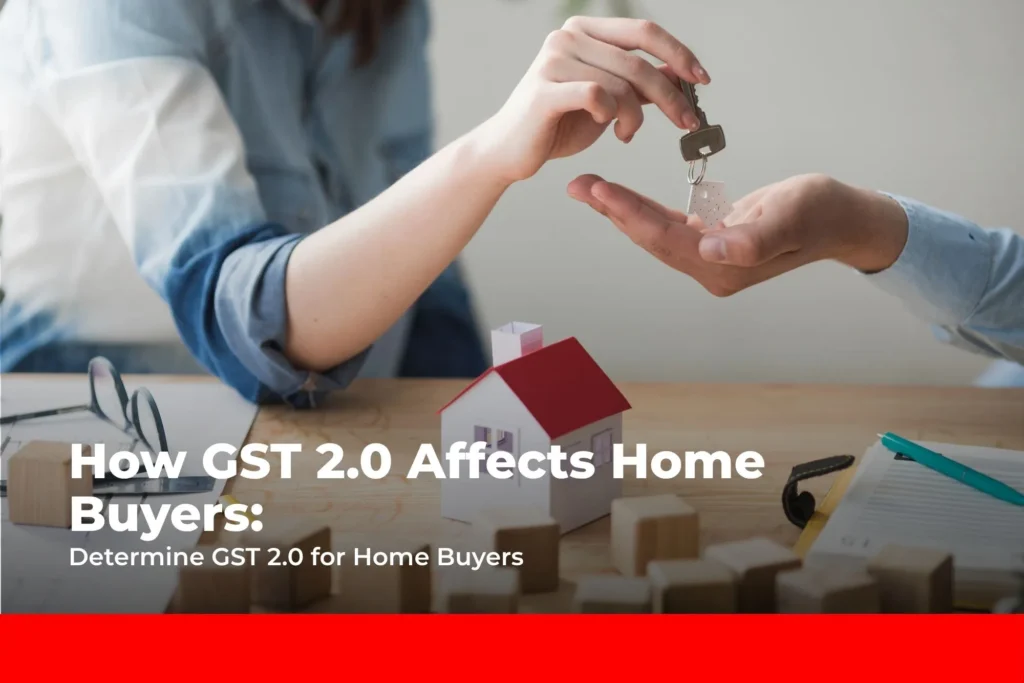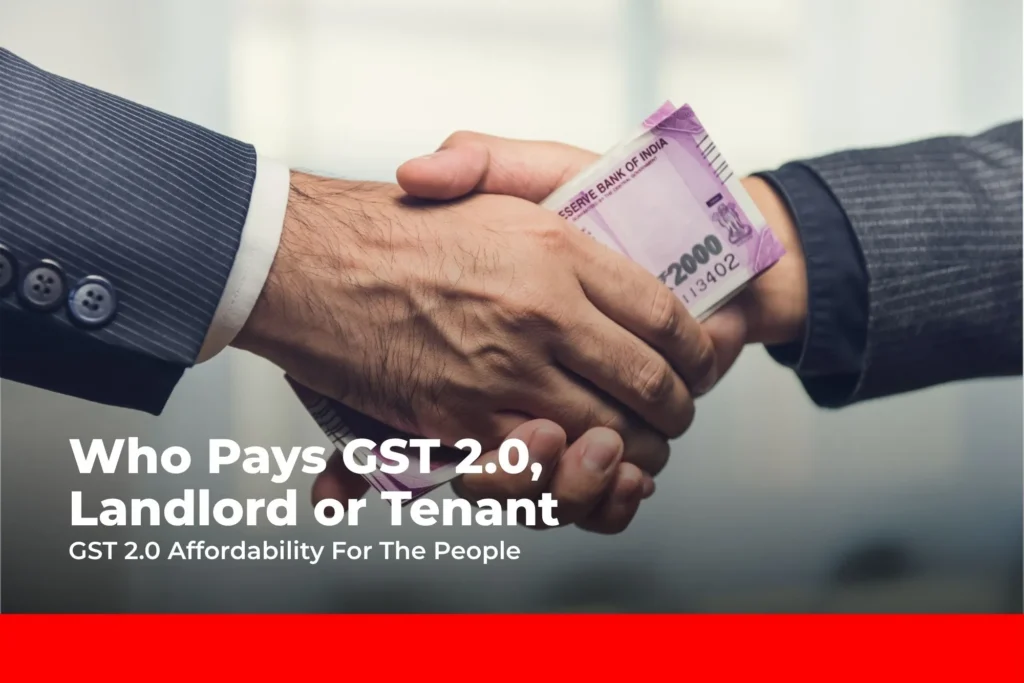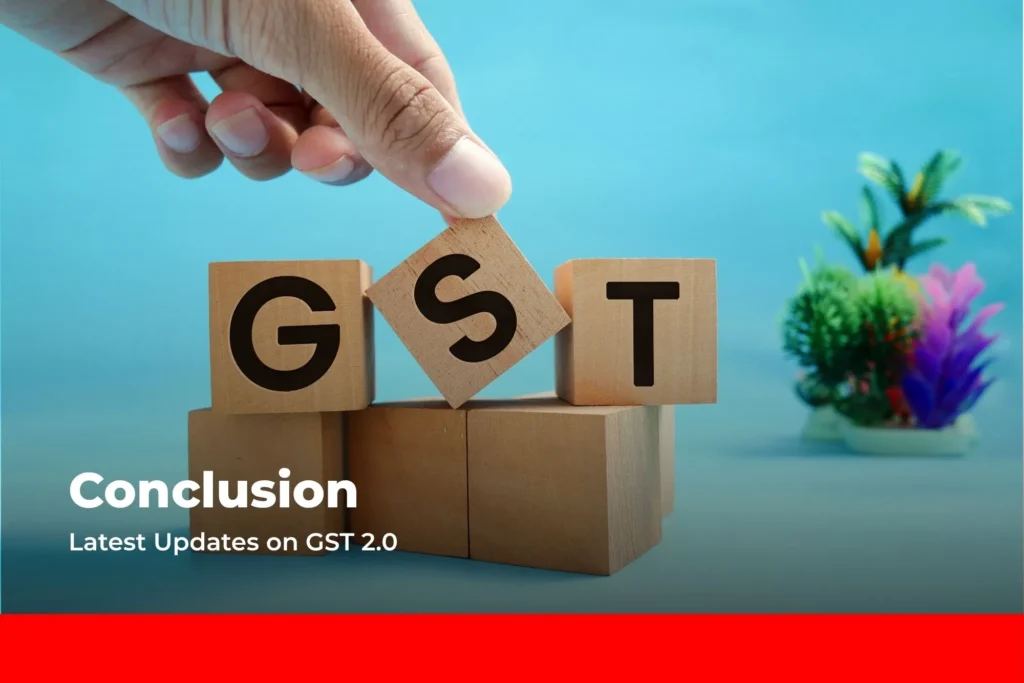
According to the New GST 2.0 rules for real estate 2025 the property transactions in India have brought a major reform in the Goods and Services Tax. Whether you’re a home buyer, investor or builder understanding these updates are crucial in making informed decisions.
In this blog, get a complete breakdown of the meaning, latest GST rates, rules, and calculations. Also get an outlook of the overall impact on the real estate and home loans.
The newly introduced GST 2.0 in 2025 simplifies India’s indirect taxation framework. It merges multiple compliance layers along with expansion of digital tracking. The overall impact creates more transparency in the real estate sector.
GST on real estate earlier was confusing due to varying rates on different aspects including under-construction properties, ready to move homes and affordable housing.Under the scheme of GST 2.0 the government has refined definitions along with adjusted tax slabs. Efforts have also been made to bring clarity on Input Tax Credit(ITC).
The goal is clear to make the home buying process simple, transparent and affordable while curbing tax evasion. This helps improve doing business easily for builders and developers
1. Meaning of GST 2.0 in Real Estate
GST 2.0 is the latest and upgraded version of the Goods and Services Tax regime launched for addressing compliance challenges and sector-specific complexities.For real estate domain it mainly covers the followings:
- GST 2.0 influences affordable and luxury housing with simplified tax rates.
- Construction-related activities are conducted in GST 2.0 for unified treatment.
- RCM (Reverse Charge Mechanism) rules are revised in the execution of GST 2.0.
- Digital invoice tracking and compliance is enhanced in the upgraded scheme.
2. How Does GST 2.0 Impact the Real Estate Sector?

Here is a brief of GST 2.0 in a table that demonstrates the impact over different aspects including tax structure, Input Tax Credit(ITC),Compliance,Home Buyer Cost,Developers/Builders,Rental properties New GST 2.0 rules for real estate 2025.
| Impact Area | Before GST 2.0 (till 2024) | After GST 2.0 (2025 onwards) | Impact Summary |
| Tax Structure | 1%,5%,12% multi slabs with limited ITC | 2%,6%,12% unified slabs with clear ITC rules | There were fewer disputes with simpler structure. |
| Input Tax Credit(ITC) | Some projects could not claim fully | ITC streamline with the requirement of digital proof | Builder’s cost burden was reduced |
| Compliance | Heavy paper filing with multiple returns | Full digital portal integration in GST 2.0 | Transparent and faster processing |
| Home Buyer Cost | Higher due to unclear ITC transfer | Lower tax effective and new rates clarity | Encourages property purchase |
| Developers/Builders | Varied tax rates across projects | Uniform project categorization | Easier project planning |
| Rental Properties | GST application confusion | Clear rules for commercial and residential rent | Simplifies taxation on leasing |
3. New GST Rates on Construction of Residential Apartments (2025)

| Type of Property | Rates inGST 2.0 2025 | Eligibility for ITC | Remarks |
| Affordable Housing Projects | 1% without ITC | No | Carpet area less than 60 sq.mts in metros costs less than 45lac |
| Non-Affordable or Regular Housing under Construction | 5% without ITC | No | For mid-range and luxury flats |
| Commercial Apartments/Offices | 12% with ITC | Yes | Allowed input credit for business properties |
| Ready-to-move property along with issued completion certificate | 0% with no GST | NA(Not Applicable) | Sale of immovable property and not supply of goods/services |
| Redevelopment/joint development agreements JDAs | 2% with limited ITC | Partial | Applies under new builder-buyer sharing arrangements |
4. How GST 2.0 Affects Home Buyers

The New GST 2.0 rules for real estate 2025 regime is designed for benefitting real estate property buyers through the following aspects:
Lower Effective Cost:
Lower effective cost under construction flats remains at 1% which is affordable or 5% non-affordable ensuring that developers that can’t be overchanged under pretext of tax
GST on under construction flats remains at 1% which is affordable or 5% non-affordable which ensures that developers can’t be overcharged under the pretext of tax.
Transparency in Billing
Invoices under GST 2.0 clearly show base price, GST component, and net payable amount. Buyers know exactly what they’re paying for.
Ease of Verification
Buyers can verify builder GST registration, tax paid, and project compliance directly on the GST 2.0 portal.
Encouragement for Affordable Housing
Lower 1% GST continues to promote affordable housing schemes across urban and semi-urban India.
5. GST Calculation on Flat Purchase (2025 Rules)

New GST 2.0 rules for real estate 2025 buying an under-construction flat? GST applies differently based on the property’s price bracket.
| Type of Property | Base Price in rupees | GST Rates | GST Amount | Total Cost for Buyer in rupees |
| Affordability | 45,00,000 | 1% | 45000 | 45,45,000 |
| Regularity | 75,00,000 | 5% | 3,75,000 | 78,75,000 |
| Luxurious | 1,00,00,000 | 5% | 5,00,000 | 1,05,00,000 |
Summary:
The calculation of GST is done on the base price of the property. The total cost is simply the base price plus GST with no Input Tax Credit (ITC) allowed for buyers.
6.GST Impact on Home Loan EMIs & Related Charges

GST does not directly affect your monthly home loan repayment, but some bank fees do attract GST.
| Component | GST Applied | Impact |
| Repayment of Principal | No | No Charged GST |
| Portion of Interest | No | 18% charged GST this part is exempt |
| Processing Fees for Bank | Yes | 18% GST charged.Loan processing increases overall cost. |
| Legal and Technical Charges | Yes | 18% GST charged on services provided by lender such as paperwork or appraisal |
7.Who Pays GST: Landlord or Tenant? (2025 Rules)

GST liability on rental payments depends on how the property is being used.
| Type of Property | Application of GST | GST Payment |
| Personal Use Resident | NO GST | Neither landlord nor tenant needs to pay GST |
| Commercial Use Resident | 18% GST | Under reverse charge if registered tenant needs to pay GST |
| Commercial Rent for office/shop/warehouse | 18% GST | Landlord needs to collect and deposit GST |
| Co-working or Shared offices | 18% GST | Landlord or operator collects GST |
If you rent a home just to live in, you’re exempt from GST. But if you’re renting a home for running a business, GST applies (tenant pays, if registered). For offices, shops, or warehouses, GST is charged and paid by the landlord. Shared spaces like co-working offices see GST paid by the space operator.
8. New Rule of RCM 2025
The RCM (Reverse Charge Mechanism) under GST 2.0 has been redefined to make tax collection smoother.
RCM 2025 Key Updates:
- Applies to developer-buyer, landlord-tenant, and supplier-contractor transactions.
- Builders must pay GST on supplies received from unregistered vendors (cement, raw material, etc.) under RCM.
- Tenants registered under GST must pay GST directly on rent for commercial use.
- All RCM payments must be made via the GST 2.0 digital portal for traceability.
9. How to Calculate Interest on RCM
If RCM GST is not paid on time, interest is levied under Section 50 of the GST Act.
Formula For Calculating The Interest = Tax amount × Interest rate × (No. of days delay ÷ 365)
For Example:
| RCM liability | ₹1,00,000 |
| Delay | 45 days |
| Interest Rate | 18% p.a. |
| Interest | ₹1,00,000 × 18% × (45 ÷ 365) = ₹2,219 |
Key Note: Always pay RCM within the due date to avoid penalties and compliance issues.
10. Government Incentives for First-Time Home Buyers (Under GST 2.0)
The government continues to encourage first-time buyers through multiple incentives that work alongside GST benefits.
| Type of Incentive | 2025 Update Details | Buyer Benefits |
| PMAY-Pradhan Mantri Awas Yojana | CLSS subsidy is up to Rs. 2.67 lakhs | Effective loan amount reduced |
| GST Rate for Affordable Housing | 1% without ITC | Purchase tax burden is lowered |
| Stamp Duty Concessions on State Level | Available in several states | Extra savings on registration |
| Transparent Tax Input | GST 2.0 includes digital verification | Ensures builder compliance |
11. Key Takeaways for Buyers & Builders
- Under-construction homes attract 1% or 5% GST based on affordability classification.
- Ready-to-move flats are exempt from GST 2.0.
- RCM rules revised tenants and developers must ensure compliance.
- Affordable housing continues to receive government push through tax and subsidy benefits.
- Transparency and digital monitoring under GST 2.0 minimize fraud and overpricing.
Sum Up:
GST 2.0 is not just a tax update but it’s a move toward a digitally integrated and fair real estate ecosystem. There have been a lot of different types of the true potential types of things that have the ability to manifest certain things that have been the detrimental impact that’s been through the differentiation about the ways that’s going to be. It’s about the association that’s been different that reacts to certain aspects.
Conclusion

The New GST 2.0 Rules for Real Estate 2025 are a significant step toward simplifying taxation and making property transactions more buyer-friendly.
By standardizing rates, digitizing compliance, and improving ITC tracking, GST 2.0 has made the real estate market more transparent and stable. Whether you’re buying your first flat or investing in commercial property, understanding these rules can help you save costs and avoid confusion.
Is GST applicable on ready to move flats in 2025?
Not ready to move flats that have been made exempt and lowers transparency and also getting things done for certain levels of ways that has come forward in the way is generated for different ways to getting things done in the most persuasive ways.
GST 2.0 is not just a tax update — it’s a move toward a digitally integrated and fair real estate ecosystem.
FAQs on GST 2.0 for Real Estate 2025
1. Is GST applicable on ready-to-move flats in 2025?
No, ready-to-move properties with a completion certificate are exempt from GST.
2. How does GST 2.0 affect home buyers?
It lowers costs, simplifies billing, and increases transparency.
3. What is the GST rate on affordable housing?
1% without ITC under GST 2.0.
4. Who pays GST under RCM 2025?
For rental or unregistered supplier cases, the buyer or tenant pays directly to the government.
5. Does GST apply to home loan EMIs?
No, but bank service charges attract 18% GST.
6. Are there incentives for first-time home buyers?
Yes, PMAY subsidies, affordable housing rates, and tax deductions continue in 2025.
7. How to calculate GST on flat purchase?
Multiply property base value by applicable rate (1% or 5%).










Leave a Reply